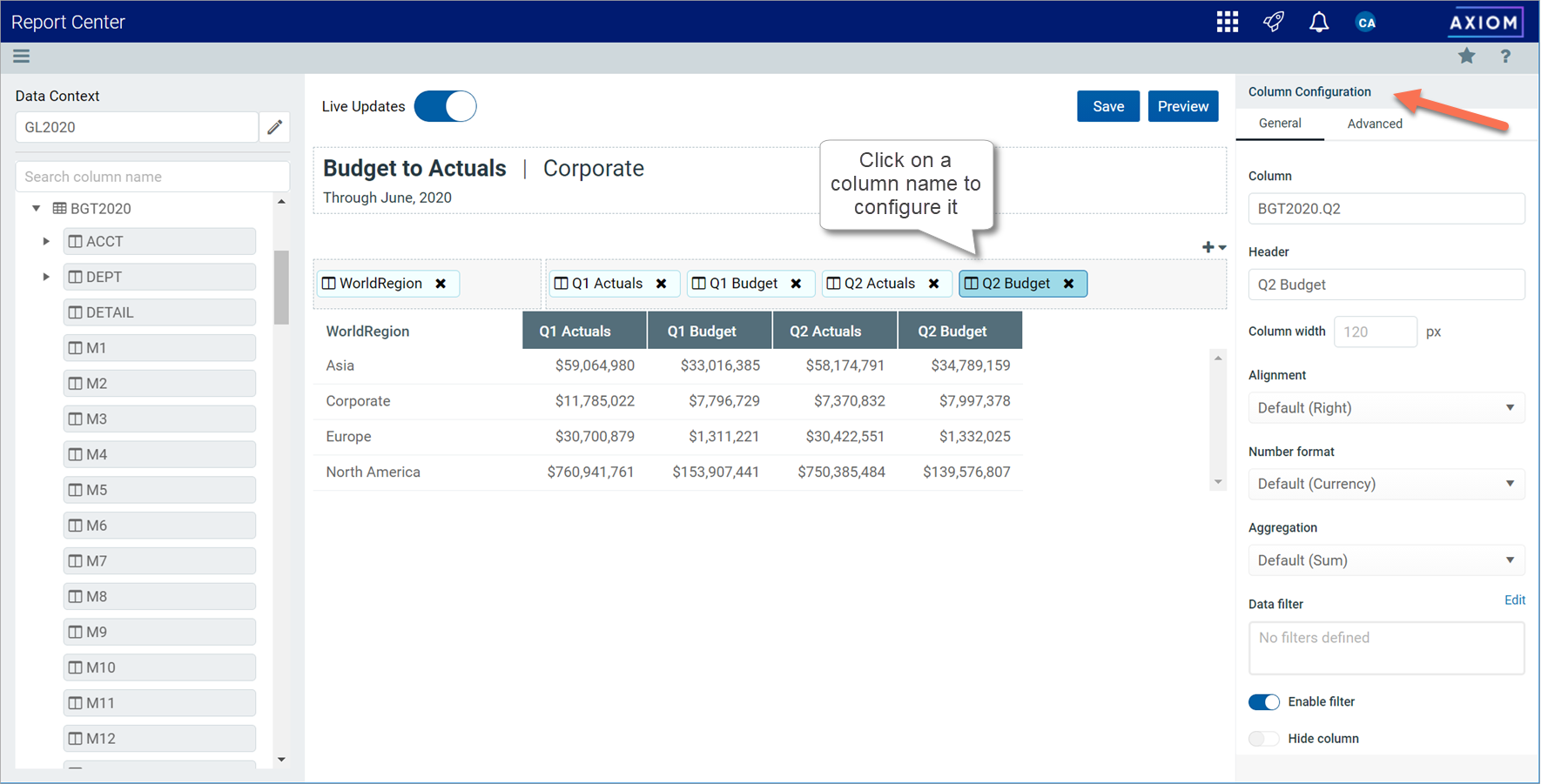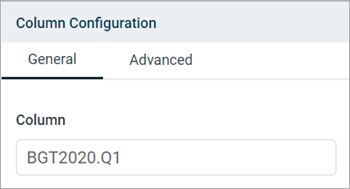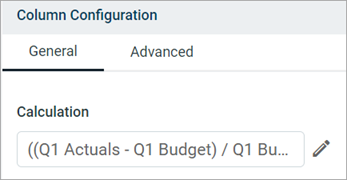AX1835
The column properties define the presentation of each column in the grid. Using the column properties, you can configure:
- Display properties such as header text, column width, alignment, and number formatting
- Data properties such as column filters, alternate aggregation, and display formats for data
- Grid behavior properties such as inclusion in the total row, and whether end users can sort and filter using the column
In the Report Builder, the column properties are defined in the right-hand Configuration Panel.
To configure column properties for a column in a web report:
-
In the Report Canvas of the Report Builder, click a column name in either the Row Dimensions box or the Column Definitions box to select that column.
You must select the column name in the setup boxes and not the column name in the grid below. Selecting a column name in the preview grid causes the Grid Configuration to display instead of the Column Configuration.
-
Complete the Column Configuration properties that display in the Configuration Panel.

The column configuration properties are separated into two tabs:
- General: Basic column properties that should be reviewed and configured for all columns in the grid.
- Advanced: Advanced column properties to be configured as needed.
General column properties
The following column properties are available for web reports on the General tab of the Column Configuration panel. These properties apply to table columns and to calculated columns.
| Item | Description |
|---|---|
|
Column or Calculation |
The following information displays at the top of the panel to identify the column:
|
|
Header |
The header text to display on the column header. Enter the desired header text.
|
|
Column width |
The width of the column in the grid, in pixels. Enter the desired column width as a whole integer between 20 and 1000. The default width depends on the column data type, and is configured at the grid level. If you do not enter a custom width, then the default width displays in the Column width box in gray text. If you leave this default width and the grid-level defaults are changed, then column will update to use the new default width. For more information, see Default column formats. |
|
Alignment |
The alignment of the column values. Select one of the following: Default, Left, Right, Center. The default alignment depends on the column data type, and is configured at the grid level. If a column is set to use Default and the grid-level defaults are changed, the column will update to use the new default alignment. For more information, see Default column formats. |
|
Number Format |
The number format used by the column. Only applies to columns that hold numeric data. Select one of the following:
|
|
Aggregation |
The aggregation type used to aggregate data queried from the database column. Does not apply to calculated columns or to columns used as row dimensions. If you want to override the default aggregation type for a database column, select an aggregation type. |
|
Data filter |
Optional. Defines a filter to limit the data shown in this column. The column-level data filter should be used instead of a grid-level data filter when you want the filter to impact just this column. Click the Edit button to open the Filter Wizard and define a filter. Once you have defined a filter, it displays in the Data filter box. If you want to change or remove the filter, click the Edit link again and change or delete the filter within the Filter Wizard. The Data filter box is not directly editable. Data filters defined at the column level are combined with any filters defined at the column group level and at the grid level. All relevant filters are combined using AND to determine the data that can display in a particular column. NOTES:
|
|
Enable filter |
Specifies whether end users can filter based on the column contents.
This property does not apply to columns used as row dimensions. It also does not apply to the entire grid if Use fixed rows is enabled in the Grid Configuration properties. Fixed row reports do not support end-user column filtering. |
|
Hide column |
Specifies whether the column is hidden in the report:
|
|
Specifies whether you want descriptions to display for dimension values. This option only applies to key columns and validated columns that have an associated description column.
NOTE: If the dimension table has multiple description columns (meaning columns where Describes Key is True), then the first description column is used. |
|
|
Include in total row |
Specifies whether the column is included in the total row, if a total row is enabled in the Grid Configuration properties. Select one of the following:
This option does not apply if Use fixed rows is enabled in the Grid Configuration properties. Columns will be included or excluded in subtotal or total rows using the default behavior. |
Advanced column properties
The following column configuration properties are available for web reports on the Advanced tab of the Column Configuration panel:
Header Properties
| Item | Description |
|---|---|
|
Header text (row 1) |
The header text to display on the column header. Enter the desired header text. NOTES:
|
|
Header text (row 2) |
The header text to display on the second row of the column header. Enter the desired header text. This property is only available if if Multi-row header has been enabled. |
|
Multi-row header |
Specifies whether the column header has multiple rows:
Keep in mind that enabling a multi-row header is different than wrapping header text. If you enable multi-row headers, then you can define two separate rows of header text. A line break separates each row. If autowrap is enabled, then each row of header text wraps individually. If you just want a single row of header text that wraps, you can leave this option disabled and then enable Autowrap header text. |
|
Autowrap header text |
Specifies whether header text wraps:
|
|
Header alignment |
The alignment of the header text. Select one of the following: Default, Left, Right, Center. All column headers use Default alignment by default. By default, the header text uses the same alignment as the column contents (as determined by the Alignment property on the General tab). If you leave the header alignment set to Default, then the header alignment will adjust to match the column alignment. If, however, you want the header alignment to be different than the column alignment, you can configure this property. |
Frequently asked questions
I defined a column filter but it isn't impacting the grid data as I expected—why do I still see rows that don't match the column filter?
A column filter only filters the data coming into that specific column. If you want to define a filter that impacts the entire report, including the row data, then you should define a filter at the grid level. Select the grid and then use the Grid Configuration properties to define a Data Filter.
To illustrate the difference, imagine the following uses of a filter to only show data from the West region:
-
Grid: When the filter
Dept.Region='West'is defined for the grid, the entire grid is filtered to only show data from the West region. Row dimension values (such as departments) will only display if they belong to the West region, and column data is limited to only show data for the West region. -
Column: When the filter
Dept.Region='West'is defined on a column, that single column is filtered to only show data from the West region. Other columns and row dimension values are not limited by this filter. You might do this if you want to create a report that shows the different region data in different columns, such as to compare data from the West, East, North, and South regions side-by-side.


